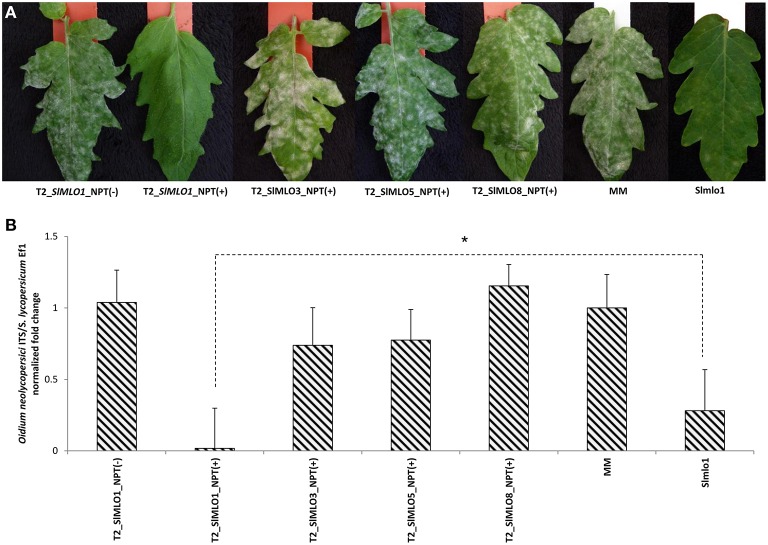Figure 5.
Powdery mildew evaluation on plants of segregating T2 families obtained with silencing constructs targeting SlMLO genes to attest their involvement in O. neolycopersici susceptibility. Panel (A) shows the phenotypic evaluation of the powdery mildew growth on leaves of different T2 individuals that have been evaluated for the (from left to right) absence of the RNAi::SlMLO1, presence of the RNAi::SlMLO1, presence of the RNAi::SlMLO3, presence of the RNAi::SlMLO5, and presence of the RNAi::SlMLO8 silencing constructs, followed by one individual of the cv Moneymaker (MM) and one of the Slmlo1 line carrying a loss-of-function mutation in the SlMLO1 gene. Panel (B) shows the relative quantification of the ratio between Oidium neolycopersici and plant gDNAs in transgenic individuals [NPT(+)] and not transgenic individuals [NPT(-)] segregating in T2 families obtained with the silencing constructs above described. Bars and standard errors refer to (from left to right) four individuals of two independent T2 families not carrying the RNAi::SlMLO1, eight individuals of the same two T2 families carrying the RNAi::SlMLO1, 18 individuals of three independent T2 segregating families carrying the RNAi::SlMLO3 construct, 18 individuals of three independent T2 segregating families carrying the RNAi::SlMLO5 construct and 20 individuals of two T2 segregating families carrying the RNAi::SlMLO8 construct, next to 10 MM plants and 10 plants of the Slmlo1 line. The asterisk refers to the significant difference in susceptibility between individuals of the T2_SlMLO1_NPT(+) and Slmlo1, inferred by mean comparisons with a Student's t-test (*p < 0.05).

